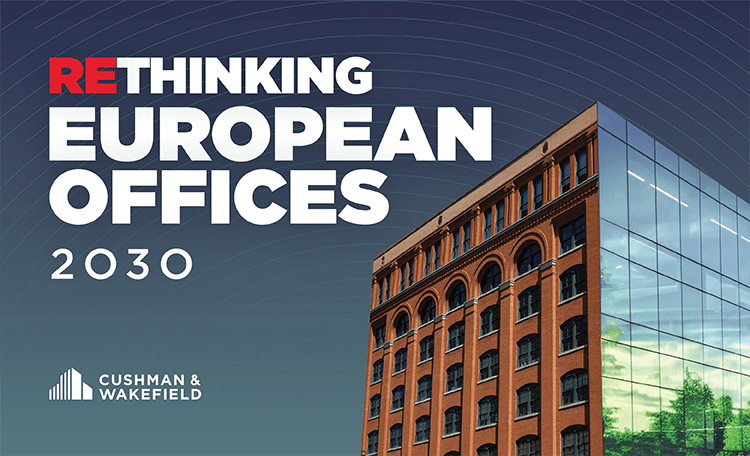Strong interest among office users in central areas is consolidating –
Peripheral locations remain at a disadvantage even with high-quality space
- Vacancy gap between core CBD office locations and those outside the core is at its highest level since Q1 2016
- Prime rents in core locations are rising at an average 3.7% per annum compared with 2.3% outside the core
- Values in core areas have risen 5% in the past year, marking four consecutive quarters of growth
As businesses prioritise the return to the office amid fierce competition for talent, Cushman & Wakefield’s latest analysis, Return to the Core, on new office space leases in 17 top business centres in Europe reveals a growing emphasis on locating within core Central Business Districts (CBDs) across Europe. Proximity to key transport hubs, operational efficiency, and access to amenity-rich environments have become central to occupier strategy and elevated location to a top priority.
Nigel Almond, Senior Director at Cushman & Wakefield, said: “In the twelve months to June 2025 close to three-quarters of leasing in key cities across Europe was in core central areas, up from around 60% pre-pandemic. This sharp rise highlights how location has become a decisive factor in occupier strategy, even as prime rents continue to rise.”
Core CBDs capturing majority of leasing activity
A total of 12.4 million sq m was leased across core European locations over the last 12 months, a 10% increase on the same period a year ago. Conversely, leasing outside the core was down 4% in the same period at 4.9 million sq m.
Twelve cities reported an increase in core leasing activity in the 12 months to Q2 2025 versus the same period a year ago. Of these, 10 reported a greater increase in core areas compared with activity outside the core, including Frankfurt, Milan, Amsterdam, Madrid and London.
Only in Prague and Hamburg did the take-up-volume outside the core areas (+11% in Prague, +10% in Hamburg) increase more strongly than in the CBDs (+8% in Prague, +3% in Hamburg). This means that the increase in take-up in both cities and in both areas remained at a low level. By way of comparison, turnover in Frankfurt's central business district rose by around 70% between the beginning of July 2024 and the end of June 2025 compared with the same period in the previous year. Contributing factors included the leasing of space by KPMG, which will relocate from a peripheral (airport) location to a central location (Opernturm and Park Tower), and the leasing of space by Commerzbank in the new ‘Central Business Tower’ project, which is already under construction. Outside the CBD, Frankfurt also saw an increase in sales volume, albeit a comparatively modest 10%.
Munich also recorded a very significant increase in its core area, with sales volume up by a third compared to the same period from July 2023 to June 2024. Outside the central business districts, Munich actually saw a decline in sales (down 8%).
Berlin, on the other hand, is one of three cities (alongside Budapest and Barcelona) that recorded declines in both central and peripheral locations, with turnover in the core areas of Berlin and Budapest declining to a greater extent. While peripheral locations in Berlin were able to maintain almost the same level as the previous year (down 3%), central areas suffered a significant decline (down 16%).
Vacancy rates and rents reflect core strength
Stronger demand has helped shrink the average vacancy in core locations. Across 18 European cities tracked, the average core vacancy rate fell to 7.1% in Q2 2025, a fall of 2bps from 7.3% in Q1, underscoring the strength and resilience of offices in these locations. In contrast, vacancy rose 2bps to 12.9% in areas outside the core. The 585bps gap in vacancy between the core and outside the core is at its highest level since Q1 2016.
Stronger leasing and lower vacancy are also driving far stronger rental growth in core locations. At the end of Q2 2025 prime rents in the core were rising at an average 3.7% per annum compared with 2.3% outside the core. Equally, over the last three years, core rents were up 13.2%, nearly double the growth outside the core (7%).
Investor confidence mirrors occupier demand
Investors are also prioritising assets in the core, reflecting the strength of demand from office occupiers for these locations. Prime yields in core areas stabilised during 2024, with the first signs now emerging of an inward movement. Yields have moved in 8bps to 5.2% in Q2 2025 from a peak of 5.3% in Q3 2024. Outside the core, prime yields moved out to 6.8%, up from 6.7% over the same period.
Consequently, values in core areas have risen 5% in the past year, marking four consecutive quarters of growth, while values outside the core declined 0.2% over the same period.
Almond added: “Looking forward we believe the shift towards core locations will remain a key focus for occupiers. Accessibility, amenities, and high-quality office environments that support flexibility, creativity, and collaboration will remain critical as companies encourage employees back to the office. Despite the availability of grade A space outside the core, occupiers are still prioritising location over quality to realise hybrid working and greater in-office collaboration.”





